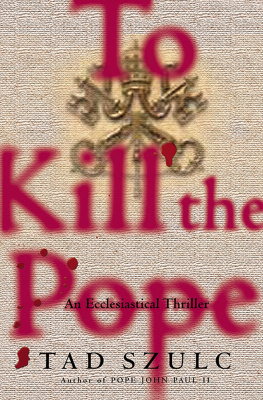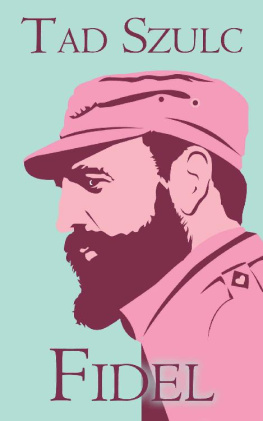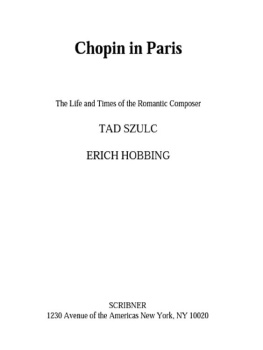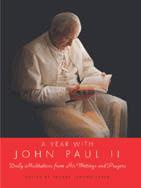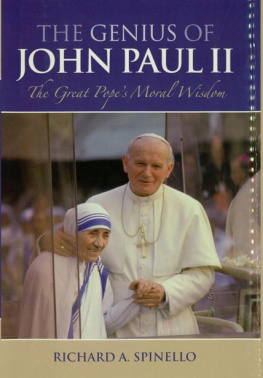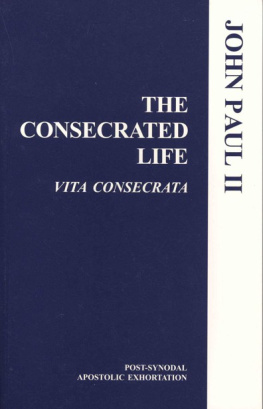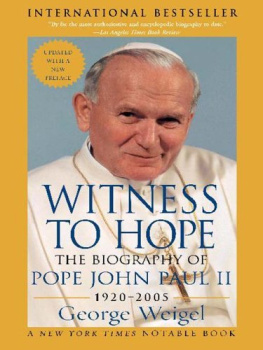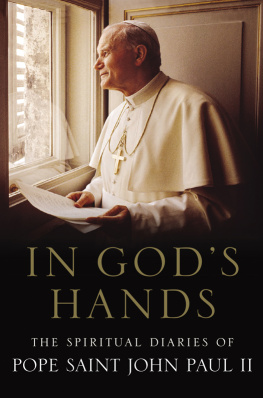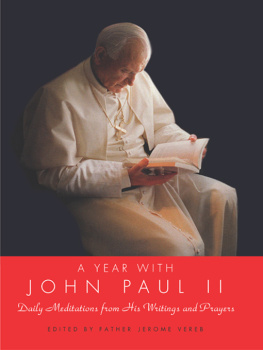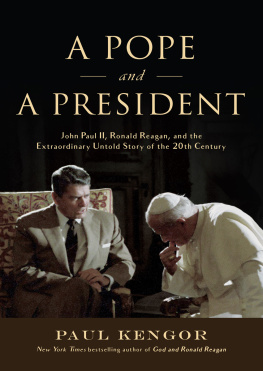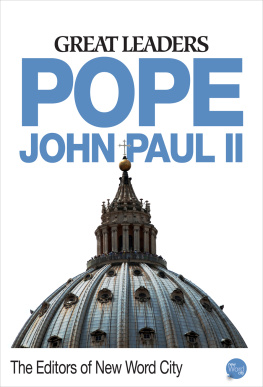ACCLAIM FOR TAD SZULCS POPE JOHN PAUL II: THE BIOGRAPHY
As close an account as we are likely to have of the way a particular culture and era gave birth to this very Polish Pope....
Margaret OBrien Steinfels, The New York Times Book Review
The most useful biography that has yet appeared in English on the Pontiffs background.
Colm Tibn, The New Yorker
Brimming with revelations.... An extraordinarily candid portrait of the Polish pontiff and a timely look at the Churchs internal crisis....
Publishers Weekly
Important and illuminating.... The books chief claim has been in revealing heretofore unknown or underreported aspects of the Popes remarkable ascent and behind-the-scenes diplomacy.... Still most readers, and especially Catholics, may find Szulcs book more rewarding for showing how the Popes Polish roots and mystical beliefs help explain his positions on such divisive issues as birth control, women in the priesthood, and priestly celibacy.... The author enjoyed extraordinary access to his countryman....
Thomas Kunkel, Lexington (KY) Herald-Leader
MORE PRAISE FOR TAD SZULCS POPE JOHN PAUL II: THE BIOGRAPHY
Adds fresh details to the portrait of John Paul II.... One feels through Szulcs guidance as though one has met Wojtya in the flesh.
Michael Novak, Washington Post Book World
Szulcs long experience covering international affairs for the Times stands him in good stead when he writes of the Popes involvement in world affairs, especially in Eastern Europe. Not surprisingly, the sections of the book dealing with John Paul II the Pole and John Paul II the statesman are the books strongest....
Michael D. Schaffer, Tampa Tribune-Times
[A] thorough and intriguing biography....
Philip Seib, Dallas Morning News
Tad Szulc enjoyed unprecedented advantages. The Vatican gave him wide and exclusive access.... Szulc can take credit for providing a wealth of invaluable detail....
Richard Griffin, Boston Book Review
[A] well-written book that deserves, and no doubt will get, a wide readership.... An accurate portrait of the direction taken by the largest religious organization in the world under the leadership of John Pauland where it might go after hes gone.
Ernst-Ulrich Franzen, Milwaukee Journal-Sentinel
What is closest to Szulcs heartJohn Pauls outreach to the Jewish people and the State of Israelis a story he tells well. What Szulc knows from personal experiencethe life of a small Polish city during the interwar yearshe describes with sympathy and insight. What he can grasp as a man conversant with Polish literaturethe special character of Wojtyas poetry and playshe writes about sensibly.
George Weigel, Seattle Weekly
Informative and illuminating.... A coherent, balanced, and plausible story of the Popes central role in helping to bring about the demise of communism.
America
Books by Tad Szulc
Twilight of Tyrants
The Cuban Invasion (with Karl E. Meyer)
The Winds of Revolution
Dominican Diary
Latin America
The Bombs of Palomares
Portrait of Spain
Czechoslovakia Since World War II
Innocents at Home
The United States and the Caribbean (editor)
Compulsive Spy
The Energy Crisis
The Illusion of Peace
Diplomatic Immunity (a novel)
Fidel: A Critical Portrait
Then and Now: How the World Has Changed Since World War II
The Secret Alliance
Pope John Paul II*
*Published by POCKET BOOKS
This book is in memory of I RENA M ONICA B ARUCH W ILEY
Some quotations from the Pope in Part II are 1994 by Andr Frossard from the book Be Not Afraid! by Andr Frossard. Reprinted with permission from St. Martins Inc., New York, New York.
Scribner, a division of Simon & Schuster, Inc.
1230 Avenue of the Americas, New York, New York 10020
www.SimonandSchuster.com
Copyright 1995 by Tad Szulc
Afterword copyright 2003 by The Estate of Tad Szulc
All rights reserved, including the right to reproduce this book or portions thereof in any form whatsoever. For information address Scribner, a division of Simon & Schuster, Inc.
1230 Avenue of the Americas, New York, 10020
ISBN 13: 978-1-4165-8886-3
ISBN 13: 978-1-4767-9469-3 (eBook)
Scribner and colophon are registered trademarks of Simon & Schuster, Inc.
Cover photograph by Grzegorz Galazka/ Inside Vatican
PREFACE
When Pope John Paul II and I first discussed my plans to write his biography, the Holy Father remarked that a biography must be more than dates, facts, and quotations... It must convey, he said in Polish, the persons heart, soul, thoughts....
In the nearly two years that have elapsed since the 1993 conversation, I had the privilege of watching John Paul II and listening to him in the privacy of his dining room in his apartments at the Apostolic Palace, in his conference room where we joked in Polish, in the public halls of the Vatican, aboard airplanes as I accompanied him on trips to Mexico, Jamaica, the United States, the Baltic countries, and the former Yugoslavia, in great cathedrals of the world and modest suburban parish churches.
I took the popes advice to study in depth Polish history and literaturehis own intellectual and emotional mainstayand looked up old friends and acquaintances he suggested I should see in Poland and elsewhere. Then I took it upon myself to work through, with much enjoyment, his immense literary output: poems, dramatic plays, essays, books on morals and ethics, articles, letters, travelogues, homilies, and sermons.
I hope that I was able to capture the essence of the persona of Karol Wojtya of Krakw and John Paul II of the Holy See, and to live up to his counsel.
This is not, of course, an authorized biography, and it is entirely my fault if I have not met his standards. But the Holy Father has afforded me extraordinary access and has shown me great kindnesswhich has made this book possible in the first place. For this, I thank him. And I know that he will appreciate that I have striven to produce as objective a biography as I could.
T.S.
Vatican City, Krakw, Warsaw, Washington, D.C.
April 1995
PART
ONE
CHAPTER
K arol Jzef Wojtya was born together with the Polish Miracle.
On Tuesday, May 18, 1920, the day of Wojtyas birth in the small southern Polish town of Wadowice, Marshal Jzef Pisudski was being triumphantly received in Warsaw, the capital of the newly independent Poland, as the conquering hero of the war with the Soviet Union. Only ten days earlier, Pisudskis young army had seized Kiev, the principal city of the Soviet UkrainePolands first major military victory in over two centuries.
Three months later, on August 15, the Feast of the Assumption of Our Lady, Polish forces commanded by the marshal repulsed at the gates of Warsaw a powerful Soviet counterattack. It became immediately known as the Miracle on the Vistula, the river bisecting the capital.
The Soviet defeat at Warsaw doomed the advance that, if unchecked, might have continued toward war-shattered Germany and Western Europe, implanting communist rule there. Lenin and Stalin had elaborated a plan to achieve this goal and the Soviets had already occupied Lithuania and Byelorussia in their westward offensive.
The 1920 Miracle on the Vistula was reminiscent of the battle of Vienna in 1683, when Polish King Jan Sobieski destroyed the Turkish armies of the Grand Vizier, Kara Mustafa, thereby preventing the Ottoman sweep across the face of Europe.
Indeed, Karol Wojtya and the resurrected Poland, partitioned for 123 years among her three predatory neighborsRussia, Prussia, and Austriacame to life virtually at the same time.
Next page
